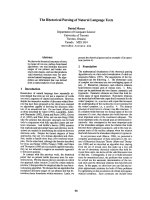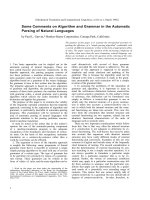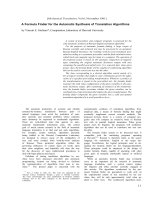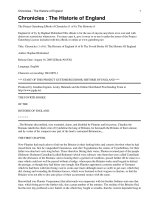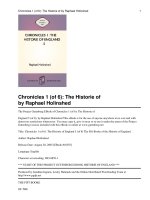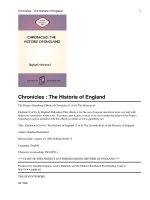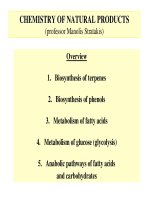Volume 8 the total synthesis of natural products
Bạn đang xem bản rút gọn của tài liệu. Xem và tải ngay bản đầy đủ của tài liệu tại đây (39.57 MB, 707 trang )
THE TOTAL SYNTHESIS OF
NATURAL PRODUCTS
The Total Synthesis
of Natural Products
VOLUME 8
Edited by
John ApSimon
Ottawa-Carleton Chemistry Institute
and
Department of Chemistry
Carleton University, Ottawa
A WILEY-INTERSCIENCE
PUBLICATION
JOHN WILEY & SONS Inc.
NEWYORK
CHICHESTER
BRISBANE
TORONTO
SINGAPORE
A NOTE TO THE READER
This book has been electronically reproduced fiom
digital information stored at John Wiley & Sons,Inc.
We are pleased that the use of this new technology
will enable us to keep works of enduring scholarly
value in print as long as there is a reasonabledemand
for them. The content of this book is identical to
previous printings.
In recognition of the importance of preserving what has been
written, it is a policy of John Wiley & Sons, Inc., to have books
of enduring value published in the United States printed on
acid-free paper, and we exert our best efforts to that end.
Copyright
0 1992 by John Wiley & Sons, Inc.
All rights reserved. Published simultaneously in Canada.
Reproduction or translation of any part of this work
beyond that permitted by Section 107 or 108 of the
1976 United States Copyright Act without the permission
of the copyright owner IS unlawful. Requests for
permission or further information should be addressed to
the Permissions Department, John Wiley & Sons, Inc.
Library of Congress Cataloging in Publication Data:
The Total synthesis of natural products.
“A Wiley-Interscience publication.”
Original imprint, v. 1: New York: Wiley-Interscience, 1973.
Includes bibliographical references and indexes.
1. Chemistry, Organic-Synthesis. I. ApSimon, John.
QD262.T655
1973
547.2
72-4075
ISBN 0-471-03251-4 (v. 1)
ISBN 0-471-54507-4 (v. 8)
10 9 8 7 6 5 4 3 2
Contributors
to Volume 8
Kim F. Albizati, Department of Chemistry, College of Liberal Arts, Wayne
State University, Detroit, Michigan
David Goldsmith, Department of Chemistry, Emory University, Atlanta,
Georgia
N. K. Kochetkov, N. D. Zelinsky Institute of Organic Chemistry, Academy of
Sciences, Moscow, USSR
Franqoise Perron, Department of Chemistry, College of Liberal Arts, Wayne
State University, Detroit, Michigan
Norman E. Pratt, Department of Chemistry, College of Liberal Arts, Wayne
State University, Detroit, Michigan
Ronald H. Thomson, Department of Chemistry, University of Aberdeen,
Aberdeen, Scotland
Valerie Vaillancourt, Department of Chemistry, College of Liberal Arts,
Wayne State University, Detroit, Michigan
V
Preface
The art and science of organic synthesis is alive and well! This volume
presents chapters on the synthesis of a variety of natural products.
A long overdue treatment of tri- and tetracyclic diterpenes appears
together with an equally important report on naturally occurring quinone
synthesis. Recent interests in the biologically important polysaccharides
necessitate a consideration of that class of compounds and a background
paper on synthetic work to 1985 is provided. Finally a diversion from the
traditional treatment of whole biosynthetic classes as synthetic targets provides an overview of strategies and methods derived for those natural
products containing the spiroketal functional group.
The announcement of the award of the 1990 Nobel Prize in chemistry to a
champion synthetic strategist, Professor E. J. Corey, attests to the scientific
importance of organic molecular construction. This volume is dedicated to
Professor Corey ( in I honor) of his multitudinous contributions to organic
synthesis.
JOHN APSIMON
Ottawa, Canada
October 1991
vii
Contents
........
1
................
245
.........
311
...
533
The Total Synthesis of Tri- and Tetracyclic Diterpenes
David Goldsmith
The Synthesis of Polysaccharides to 1986
N. K. Kochetkov
The Total Synthesis of Naturally Occurring Quinones
Ronald H. Thomson
The Total Synthesis of Spiroketal-Containing Natural Products
Valerie Vaillancourt, Norman E. Pratt, Franqoise Perron, and
Kim F. Albizati
Index
.....................................
693
ix
THE TOTAL SYNTHESIS OF
NATURAL PRODUCTS
The Total Synthesis of Natural Products, Volume8
Edited by John ApSimon
Copyright © 1992 by John Wiley & Sons, Inc.
The Total Synthesis of
Tri- and Tetracyclic
Diterpenes
DAVID GOLDSMITH
Department of Chemistry. Emory University. Atlanta. Georgia
Introduction . . . . . . . . . . . . . . . . . . . . . . . . . . . . . . . . . . . . . . . . . . . . .
1 . Tricyclic Diterpenes . . . . . . . . . . . . . . . . . . . . . . . . . . . . . . . . . . . . . .
A. Abietanes and Pimaranes . . . . . . . . . . . . . . . . . . . . . . . . . . . . . . .
(1) Resin Acids . . . . . . . . . . . . . . . . . . . . . . . . . . . . . . . . . . . . .
(2) Sandaracopimaradieneand Pimaradiene . . . . . . . . . . . . . . . . . . . .
(3) Rimuene . . . . . . . . . . . . . . . . . . . . . . . . . . . . . . . . . . . . . . .
(4) Dolabradiene . . . . . . . . . . . . . . . . . . . . . . . . . . . . . . . . . . . .
(5) Oryzalexin A. 9. and C . . . . . . . . . . . . . . . . . . . . . . . . . . . . . .
(6) Rosenonolactone . . . . . . . . . . . . . . . . . . . . . . . . . . . . . . . . . .
(7) Fichtelite . . . . . . . . . . . . . . . . . . . . . . . . . . . . . . . . . . . . . . .
(8) Phenols. Quinones. and Epoxides . . . . . . . . . . . . . . . . . . . . . . . .
B. Cassanes and Totaranes . . . . . . . . . . . . . . . . . . . . . . . . . . . . . . . .
(1) Cassane . . . . . . . . . . . . . . . . . . . . . . . . . . . . . . . . . . . . . . .
(2) Totarane . . . . . . . . . . . . . . . . . . . . . . . . . . . . . . . . . . . . . . .
2. Tetracyclic Diterpenes. . . . . . . . . . . . . . . . . . . . . . . . . . . . . . . . . . . . .
A. Phyllocladene. . . . . . . . . . . . . . . . . . . . . . . . . . . . . . . . . . . . .
B. Kaurene . . . . . . . . . . . . . . . . . . . . . . . . . . . . . . . . . . . . . . . . . .
C. Kaurenoic Acid . . . . . . . . . . . . . . . . . . . . . . . . . . . . . . . . . . . . .
D. Kaurene- 1 1. 15-diol . . . . . . . . . . . . . . . . . . . . . . . . . . . . . . . . .
E. Atiserene . . . . . . . . . . . . . . . . . . . . . . . . . . . . . . . . . . . . . . . . .
2
5
5
5
34
36
37
38
39
40
41
93
93
96
101
103
108
111
113
115
1
The Total Synthesis of Tri- and Tetracyclic Diterpenes
2
Hibaene . . . . . . . . . . . . . . . . . . . . . . . . . . . . . . . . . . . . . . . . . .
Stachenone . . . . . . . . . . . . . . . . . . . . . . . . . . . . . . . . . . . . . . . .
Hibaol . . . . . . . . . . . . . . . . . . . . . . . . . . . . . . . . . . . . . . . . . . .
Steviol . . . . . . . . . . . . . . . . . . . . . . . . . . . . . . . . . . . . . . . . . . .
Trachylobane . . . . . . . . . . . . . . . . . . . . . . . . . . . . . . . . . . . . . . .
K . Gibberellins . . . . . . . . . . . . . . . . . . . . . . . . . . . . . . . . . . . . . . .
(1) Degradation Products . . . . . . . . . . . . . . . . . . . . . . . . . . . . . .
(2) Cz0 Gibberellins . . . . . . . . . . . . . . . . . . . . . . . . . . . . . . . . . .
(3) C,, Gibberellins . . . . . . . . . . . . . . . . . . . . . . . . . . . . . . . . . .
L. Antheridiogens . . . . . . . . . . . . . . . . . . . . . . . . . . . . . . . . . . . . . .
(1) Antheridiogen-An . . . . . . . . . . . . . . . . . . . . . . . . . . . . . . . . .
(2) Antheridium-Inducing Factor . . . . . . . . . . . . . . . . . . . . . . . . . .
M . Aphidicolin . . . . . . . . . . . . . . . . . . . . . . . . . . . . . . . . . . . . . . . .
N . Maritimol . . . . . . . . . . . . . . . . . . . . . . . . . . . . . . . . . . . . . . . . .
0. Stemarin, 2-Desoxystemodinone, Stemodinone, and Stemodin . . . . . . . .
3. Unusual Skeletal Types . . . . . . . . . . . . . . . . . . . . . . . . . . . . . . . . . . . .
A . Laurenene . . . . . . . . . . . . . . . . . . . . . . . . . . . . . . . . . . . . . . . . .
B. Jatropholone A and B . . . . . . . . . . . . . . . . . . . . . . . . . . . . . . . . .
C Bertyadionol . . . . . . . . . . . . . . . . . . . . . . . . . . . . . . . . . . . . . . .
D . Pleuromutilin . . . . . . . . . . . . . . . . . . . . . . . . . . . . . . . . . . . . . . .
E. Trihydroxydecipiadiene . . . . . . . . . . . . . . . . . . . . . . . . . . . . . . . . .
F. Dolastatrienol . . . . . . . . . . . . . . . . . . . . . . . . . . . . . . . . . . . . . .
G . Eremolactone and Isoeremolactone . . . . . . . . . . . . . . . . . . . . . . . . .
H ent-Taxusin . . . . . . . . . . . . . . . . . . . . . . . . . . . . . . . . . . . . . . . .
I
Isoagathalactone and Other Sponganes . . . . . . . . . . . . . . . . . . . . . . .
J
Isoaplysin-20 . . . . . . . . . . . . . . . . . . . . . . . . . . . . . . . . . . . . . . .
K . Ryanodol . . . . . . . . . . . . . . . . . . . . . . . . . . . . . . . . . . . . . . . . .
References . . . . . . . . . . . . . . . . . . . . . . . . . . . . . . . . . . . . . . . . . . . . . .
F.
G
H.
I.
J.
118
.
.
.
.
.
..
120
120
123
127
131
131
142
148
170
170
172
174
190
196
205
205
210
211
214
217
219
222
226
228
229
231
236
INTRODUCTION
This review covers the synthesis of tri- and tetracarbocyclic diterpenes”
from the late 1930s until approximately 1987. Some synthetic work from 1988
and 1989 is included. In keeping with the title of the series. the syntheses
reviewed here are largely total syntheses. Conversions of one natural product
into another are. for the most part. not included. The decisions as to which
partial syntheses to cover were made on an almost entirely arbitrary basis.
Much excellent chemistry has emerged from partial syntheses and conversions. but the general principal has been that if the starting material appears
to be more complex and/or more difficult to synthesize than the target
molecule. the work is not included. In addition. the field of diterpene
synthesis is marked by a myriad of excellent model studies. I have not
included. however. preliminary or model study work except when directly
applicable to a particular synthesis.
The chapter is organized broadly around skeletal types and these are given
in Table 1. Within the general class of abietanes and pimaranes a further
Table 1 Synthesized Diterpene Skeletal Types
2
3
19
podocarpane
18
pimarane
abietane
@
gp @?
q
d93
17
&17
16
G@
15
cassane
totarane
7 I @
8
kaurane
17
12
13
stemodane
gtbbane
antheridane
15
I8
18
20
stemarane
taxane
17
@I7
trachylobane
beyerane
atisane
18
jatrophane
3
4
The Total Synthesis of Tri- and Tetracyclic Diterpenes
*
Table 1 Synthesized Diterpene Skeletal Types (Continued)
18
1
lathyrane
dolabrane
15
20
eremane
15
Q1
dolastane
rosane
mutilane
20
18
decipiane
ryanodane
division along the lines of major functionality is also made. Abietane C-ring
phenols, epoxides, and quinones, for example, are discussed separately from
abietic and related acids. The biosynthesis of the diterpenes is not discussed in
detail but the the origin of some of the compound types from geranylgeraniol
pyrophosphate is outlined to illustrate the structural relationships between
members of a general class of substances.
As noted in an earlier volume in this series, the proof of the synthesis
review pudding is in the synthetic schemes, and I have attempted to make
these as explicit as possible, both with regard to the number of structures in
each scheme and in the way that they are presented graphically. In some cases
the same molecule may be shown in different structural representations
depending on how these may illustrate a particular synthesis. I have also
repeated the structures of many of the starting materials and intermediates so
that the reader will not have to search for structure 43 when it is used again
Tricyclic Diterpenes
5
for the synthesis of molecule 277. The discussions of the syntheses in contrast
are brief, serving to illustrate some of the more critical points of stereochemistry or strategy or to serve simply as a guide to the structural road map.
I apologize in this respect for being unable (and unwilling) to search out and
use any additional synonyms for yield, produce, afford, provide, give, and
lead to in describing the outcome of a particular transformation. The normal
three- and four-letter codes for reagents are used throughout.
Finally, I would like to acknowledge the aid of several graduate students
in chemistry at Emory University, in particular Guy Stone, Kevin Swiss, and
William Hinkley, for their aid in searching out and gathering the relevant
literature.
1. TRICYCLIC DITERPENES
A. Abietanes and Pimaranes
(1) Resin Acids
Podocarpic Acid
The first synthesis of podocarpic acid, 1, in which the product was compared
to the natural compound and its constitution verified was carried out by
King, King, and Topliss3 at Nottingham University (Scheme 1). The carbon
skeleton is assembled by addition of Grignard reagent 2 to ketone 3.
Catalytic hydrogenation of the acetylene group of 4 affords 5, which in turn is
subjected to acid-catalyzed cyclization with polyphosphoric acid. The product of this unselective reaction is a mixture of several isomers from which 6 is
isolated in 30% yield. Hydrolysis of the ester and ether groups of 6 by
standard, if drastic, methods affords podocarpic acid. The King group also
demonstrated that the compound prepared earlier but not identified by
Haworth and Moore4 (Scheme 2) at Sheffield was podocarpic acid.
The synthesis of podocarpic acid by Wenkert and Tahara’, from Iowa
State University (Scheme 3) is based on a Robinson annelation construction
of the tricyclic system7 from 1-methyl 2-naphthol and methyl ethynyl ketone.
The highly unsaturated hydroxyketone 7 obtained in 26% yield is subjected
to catalytic hydrogenation and acid-catalyzed dehydration to yield enone 8.
Lithium in ammonia affords the trans-fused saturated tricyclic ketone 9. The
latter, upon carbonation of the kinetically produced enolate mixture, yields
the C-4 keto acid in near equal measure with its C-2 isomer. Both products
are isolated as the derived methyl esters and 10, the appropriate one for
podocarpane synthesis, is carried forward. When methylation of 10 is carried
The Total Synthesis of Tri- and Tetracyclic Diterpenes
6
3
2
4
(&Q
PPA
_
1
CH3
COIEt
@1. KOH
2.
1 HBr
HOAc
OCH,
CH
5
C0,Et
8
2
CH3
H
C02H
1
podocarpic acid
8
SCHEME 1. King’s synthesis of podocarpic acid.
1
podocarpic acid
SCHEME 2. Podocarpic acid synthesis of Haworth and Moore.
out with t-butoxide and methyl iodide the reaction provides a mixture of
products in the ratio of 2.4 to 1 with the desired podocarpane system 11 as
the minor isomer. Clemmensen reduction of the ketone function gives
desoxypodocarpic acid methyl ester and the derived acid is resolved via its
Tricyclic Diterpenes
7
7
&
CH;
$
10
9
8
C02Me
13
1.CF,C03H
2.
hydrolysis
~
8
CHt
CO2H
1
podocarpic acid
SCHEME 3. Wenkert first synthesis of podocarpic acid.
+
cinchonine salt to yield the natural series isomer ( )-desoxypodocarpic
acid 12.
In previous work Wenkert and Jackson' showed that desoxypodocarpic
acid can be reconverted to the natural product 1 by acetylation of the methyl
ester of 12 to give 13 followed by Baeyer-Villiger (Emmons) oxidation and
reductive cleavage of the C-4 axial ester group.
The second synthesis of podocarpic acid by Wenkert and co-workersg
(Scheme 4) features an alternative preparation of keto ester 11 starting from
P-tetralone 14. Alkylation and reduction of Robinson annelation product 15
affords 11 in a more efficient fashion than the original synthetic scheme.
The synthesis of podocarpic acid by Meyer and Maheshwari" at the
University of Arkansas (Scheme 5 ) differs from most other approaches to this
molecule in the manner in which the stereochemistry at C-4 is introduced.
0
8
l
l
IqflM
SCHEME 4. Wenkert's alternative synthesis of an intermediate for podocarpic acid.
LI / NH,
0'
1. EtOzCH / NaH
2 i-PrCI / H,CO,
' H
CH3
CH3
17
LAH
o&
HCO
&'I
1. 0,
KOH
2. Br, / HBr
&I,
18
19
20
OH
1
12
1
podocarpic acid
SCHEME 5. Meyer's synthesis of podocarpic acid.
8
: H
b13
N2H4
6H3
16
0
21
*
Tricyclic Diterpenes
9
Rather than introducing a methyl or potential carboxyl group as an electrophile, a one-carbon unit is added by 1,Cnucleophilic addition to a tricyclic
enone 16. Starting from the standard Robinson annelation product 17, the
key intermediate 16 is prepared by an enone transposition sequence. The key
step in the transposition is the Wolff-Kishner reduction of 18, which gives the
exocyclic olefin 19 rather than the endocyclic isomer. Addition of the Nagata
reagent to enone 16 occurs in an axial sense to produce the podocarpic nitrile
stereochemistry of 20. Subsequent removal of the C-2 keto group to produce
nitrile 21 and conversion of the nitrile function to a carboxylic acid one yields
an intermediate, 12, which had been carried through to podocarpic acid.'
The approach of Spencer and co-workers" at Dartmouth College to
podocarpic acid (Scheme 6) is to construct an aromatic C-ring onto a
i
22
25
1 (CH,CH,SH),
CrO,
___t
HC02Et
___I)
2. Ra-Ni
_.___L_
acetone
NaH
27
26
0
OH
Me,NCH,CH,COCH,
I
NaOMe
#' 'co,,
'C02CH3
28
29
..-_
--_-___
-+
.'
'C02CH3
30
podmarpic acid
SCHEME 6. Synthesis of podocarpic acid methyl ester by Spencer.
10
The Total Synthesis of Tri- and Tetracyclic Diterpenes
preexisting A/B system. The desired intermediate for the achievement of this
plan is ketoester 22. Initial attempts to produce 22 by carbonation of enolate
23 (generated by lithium-ammonia reduction of 24) were unsuccessful.
Instead 22 is prepared as the minor product from alkylation of saturated
ketoester 25.
To carry 22 forward it is converted into its ethylene thioketal derivative
and the latter function is removed by Raney-nickel desulfurization to yield
26. Oxidation yields 27, which in turn is condensed with ethyl formate to yield
the enolic keto aldehyde 28. Robinson annelation affords unsaturated ketone
29, which upon NBS oxidation provides podocarpic acid methyl ester, 30.
Ireland and Giarrusso12 at the University of Michigan carried out a
synthesis of podocarpic acid (Scheme 7) employing the same general strategy
used by Ireland and Kier~tead'~.
l 4 for the synthesis of dehydroabietic acid,
68. Thus a ring-A unit, 31, bearing at one a position an aromatic group for
ring-C and a methyl group for the angular substituent plus the potential C-4
methyl group at the other a carbon is alkylated first with methyl vinyl ketone
to give 32. In contrast to the epimeric substance used in the synthesis of
dehydroabietic acid, the aldol cyclization of 32 to 33 is accompanied by a
competing reverse Michael reaction to give substantial amounts of the
starting material 31. Since a 1,4-diketo system would not be subject to the
reverse Michael process, 31 is alkylated instead with methallyl chloride and
the methallyl group is oxidatively cleaved to yield 34. The alkylation reaction
occurs preferentially from the least-hindered face of the enolate, that is, away
from the phenyl group yielding the podocarpic acid stereochemistry. Aldol
condensation then produces the fused bicyclic enone 35.
The stereochemistry of the eventual A/B ring junction is established by
catalytic reduction after conversion of 35 to a-diketone 36. Chemical reduction of 35 does not proceed with great stereoselectivity, but the catalytic
process produces only the desired geometry. Oxidative cleavage of the fivemembered ring of the reduction product 37 then affords a diacid, 38, which
upon cyclization and hydrogenolysis affords desoxypodocarpic acid, 39. This
compound is then carried through to the racemic natural product 1 using the
method of WenkerLs
The starting material for the synthesis (Scheme 8) of podocarpic acid by
Kuehne and Nelson15*l6 from the University of Vermont is 7-methoxy-Ptetralone, 40. Methylation to afford 41 and Robinson annelation leading to
tricyclic ketone 42 is followed by base-catalyzed epoxidation affording epoxy
ketone 43. Treatment of 43 with sodium cyanide proceeds via displacement
and elimination to form the enone nitrile 44. Two sequences are employed,
both unfortunately going in low yield, to proceed to the saturated cyanoketone 45. In each case, however, the desired A/B trans-fused product is
obtained.
Tricyclic Diterpenes
11
0
2.
..
\
31
1 K-t-BUO /
CH,=C(CH,)CH,CI
2. MCPBA
3. HIO,
CHf
34
SeO
2
0
1 NaBH,
35
c
2 H,/Pd*C
38
39
HOAc
1
podocarpic acid
SCHEME 7. Ireland's synthesis of podocarpic acid.
Alkylation of 45 occurs anti to the angular methyl group to give 46 with
the correct podocarpic acid stereochemistry. Another synthesis (Scheme 9) of
this intermediate had been done earlierl5 by conversion of 42 to 47 via the
A1*2-unsaturated ketone 48. Alkylation of the unsaturated keto nitrile 47 also
yields the podocarpic acid stereochemistry. The saturated alkylation product
46 of Scheme 8 is converted into olefin 46a, thence to podocarponitrile methyl
ether 49 by catalytic reduction. Methods which normally result in reduction
40
41
42
46
PdC / H,
-
46a
2 NaH / Me1
3. NOCl / Ac,O
4. KOH
5 AC,O
49
/ HI / P
1
podocarpic acid
SCHEME 8. Kuehne's synthesis of podocarpic acid.
12
Tricyclic Diterpenes
NaOMe
CH,I
K0t.B"
0
:
EN
-
-
PdC / ti,
o&
CH f'
13
46
CN
41
SCHEME 9. Kuehne's alternative synthesis of a podocarpic acid intermediate.
of a carbonyl group to a saturated carbon, for example, the Clemmenson
reduction, when applied to ketone 46 yield the partial reduction product 46a.
To obtain podocarpic acid methyl ether the nitrile, 49, is subjected to a
four-step sequence of partial hydrolysis, methylation, and nitrosation of the
resulting amide and hydrolysis of the N-nitroso intermediate. Ether cleavage
was carried out by the method of Haworth and Moore.4
For a chiral synthesis of podocarpic acid, Yamada and co-workers17-19at
the University of Tokyo first carried out the preparation of keto-aldehyde 50
using (R)-pyrrolidonmethyl pyrrolidine as catalyst for the addition of aldehyde 51 to methyl vinyl ketone (Scheme 10). The product of .this asymmetric
synthesis, 50, is chiral but the optical yield is only 42% e.e. For the synthesis
of the target molecule only one other stereogenic center, C-5 with its
a-disposed hydrogen, must be set. To do so the Yamada group converted 50
to enone 52, a compound used by Welch2' in his synthesis of racemic
podocarpic acid. In the course of the conversion of 50 into 52 several of the
intermediates contain chiral centers other than the one at C-10 established in
the initial Michael addition. For example, 53 has a secondary hydroxyl at C-5
and 54, produced by addition of the lithium enolate of dimethyl acetamide to
55, has a tertiary hydroxyl and an acetamido chain at the same position. The
chirality at C-5 of these compounds is lost in the course of the synthesis, but
it is interesting to note that in every case the assignment of the relative
configuration at C-5 is most probably incorrect.
14
The Total Synthesis of Tri- and Tetracyclic Diterpenes
50
51
53
52
56
1
podocarpic acid
56a
SCHEME 10. Yamada’s synthesis of podocarpic acid.
For example, in one series of experiment^'^ enone 56 is subjected to basecatalyzed epoxidation. On the basis of the difference in A-value” between a
phenyl group and a methyl group, the major epoxide product is assigned the
stereochemistry shown in 56a, that is, axial attack of the epoxidizing agent
has occurred from the side opposite to the “axial methyl group.’’ In fact, a
thorough conformational search22 of 56 by use of molecular mechanics
calculation^^^ indicates that the major conformer of 56 (72%) is the one with
an axial phenyl group! The minor conformer (28%) is the one with the methyl
group in the axial position. Since it is unlikely that major differences in the
rate of epoxidation would occur between these two conformers, the ratio of
Tricyclic Diterpenes
15
products ought to reflect the initial conformer populations. Indeed the
products are obtained in the proportion of 3.5:1 (78-22%), but the assignment of stereochemistry appears to be reversed.
The Ghatak24 synthesis of podocarpic acid (Scheme 11) from the Indian
Association for the Cultivation of Science follows the pattern of the original
King approach3 but is more highly stereoselective. Starting from ketone 57 a
mixture of lactones 58 and 59 is produced in a ratio of 9 : 1. When subjected to
acid-catalyzed cyclization, this mixture affords podocarpic acid methyl ether
60 as the sole crystalline product in 41% yield. This material as noted has
been carried forward to podocarpic acid.
80
1
podocarpic acid
SCHEME 11. Ghatak's synthesis of podocarpic acid.
In the W e l ~ h ~ O -syntheses
~'
of podocarpic acid done at the University of
Houston, the C-4 methyl group is introduced by alkylation of an exocyclic
ester enolate (Scheme 12). This is in contrast to the more general use of the
enolate of a C-3 keto group. In accord with the other syntheses in this
domain, however, alkylation again occurs from the CI face of the nucleophilic
carbon. In the approach used by Welch, tricyclic enone 61, produced by
standard means, is converted through dissolving metal reduction, carbonation, and esterification to P-ketoester 62. 0-alkylation then provides enol
ether 63,which in a second lithium in ammonia reaction undergoes reduction, elimination, and then reduction again to provide the enolate ion of the
C-4 ester group. Upon addition of methyl iodide, alkylation occurs principally from the least-hindered face of the anion and ester 64 is produced.
Cleavage of both ester and ether functions yields podocarpic acid.
16
The Total Synthesis of Tri- and Tetracyclic Diterpenes
-
1.Li / NH,
___)
2 co,
3. CH2N2
NaOEt
81
OCH,
OCH3
I
83
62
OH
I
I. n+rS
+
Li
___)
2. HI / HOAc
64
1
podocarpic acid
SCHEME 12. Welch’s synthesis of podocarpic acid.
Callitrisic Acid and Alkylation Stereochemistry
The first synthesis of a resin acid, callitrisic acid, 65, was carried out in 1939
by Haworth and Baker2* (Scheme 13). The publication of the work was
“desirable in view of the intention of Sterling and Bogert to enter the same
field.” The synthetic scheme is an extension of the “Bogert-Cook” route to
phenanthrene derivative^.^^. 30 The substituted P-keto ester 66 is reacted with
a substituted phenylethyl magnesium bromide to afford alcohol 67. Following dehydration, acid-catalyzed cyclization provides one of the isomers of
dehydroabietic acid in approximately 13% yield. At the time of publication
this product could not be compared with naturally occurring material short
of a resolution. Twenty-four years later, Sharma, Ghatak, and Dutta31
demonstrated that the product obtained by Haworth and Baker is callitrisic
acid, 65.
+&;(
E10$
CH3
ClMg
66
p
Tricyclic Diterpenes
__.c
17
@
/
EtO&
CH,
67
65
callitrisic acid
SCHEME 13. Haworth’s synthesis of callitrisic acid.
A partial synthesis of callitrisic acid was carried out by Pelletier and
Herald3’ (Scheme 14) by “inverting” C-4 of dehydroabietic acid. Thus the
natural product, 68, is oxidatively decarboxylated to yield a mixture of dienes
from which the exomethylene compound 69 is isolated in moderate yield.
Epoxidation, rearrangement to aldehyde 70, methylation from the lesshindered a face, and final oxidation affords callitrisic acid, 65.
A partial synthesis was also carried out by Huffmad2 at Clemson
University (Scheme 15). Following the procedure of Campbell and Todd,33
O-methyl podocarpic acid methyl ester 64 is converted into the isopropylsubstituted ether 71. Cleavage of the ether group is followed by formation of
the phenyltetrazole derivative 72. Hydrogenolysis provides 73, the methyl
ester of callitrisic acid.
In the Welchz6.27 synthesis of callitrisic acid a tricyclic intermediate 77
(Scheme 16)is constructed by a twofold annelation sequence starting from 74.
“Friedel-Crafts” acylation of 75 with concomitant cyclization affords 76, and
subsequent Robinson annelation affords 77. By dissolving metal reduction
and carbonation 77 is converted into the trans-fused keto ester 78. As in the
podocarpic acid synthesis, an enol ether, 79, is prepared and further reduction
again effects the loss of the C-3 oxygen with production of an ester enolate at
C-4. Addition of methyl iodide to yield 80, followed by demethylation of the
ester group, affords callitrisic acid, 65.
An alternative synthesis of callitrisic acid was carried out in a joint effort
by Carman and c o - ~ o r k e r at
s ~Queensland
~
and Mori and Matsui at Tokyo.
Enone (Scheme 17) is prepared either by the method of Barltrop and Day,35
68
.
69
66
callilfisic acid
SCHEME 14. Partial synthesis of callitrisic acid by Pelletier.
OCH,
1. AcCl / AICI,
2 . CH,MgCI
71
64
2-"
72
/++
Ph
l3
callitrisic acid
methyl ester
SCHEME 15. Huffman's formal synthesis of callitrisic acid.
18



